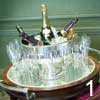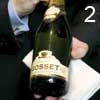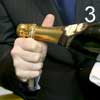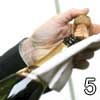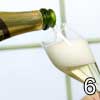Champagne masterclass
The fact that Champagne remains unchallenged as the greatest sparkling wine region in the world is down to one simple reason: no one else would want to grow grapes in an area that replicates the soils and climate of Champagne. It borders on the uppermost latitude of grape-growing possibility. It does not benefit from the wide, steep-sided valleys of the Mosel river, which temper the climate and help control frosts, nor from the effect of the Vosges Mountains, which capture rainfall before it lands on the vineyards of Alsace.
Champagne's chalky soils add further levels of acidity to the grapes that struggle to ripen in its cool, damp climate. The wines produced here are pale green and razor sharp with acidity. If you have an ocean full of fresh seafood on your doorstep, then - as with Muscadet - the wine is perfect, but in Champagne they have to go one step further in the winemaking process to produce something really special.
The key to making great sparkling wine is to start with a very neutral base white wine, a "blank canvas", to which sugar and yeast is added, inducing a second fermentation. This is the basis of the Champagne method, or méthode champenoise (a term controlled by the EU since 1985 - now called méthode traditionelle or méthode classique by anyone not in the Champagne region).
The second fermentation takes place in bottle, where several things happen. First, CO2 is produced as a by-product. Normally this is allowed to escape, but in sealed bottles it becomes absorbed into the wine to be released as bubbles. Afterwards, when the yeast dies, it falls as sediment and over time adds complexity, richness and mouthfeel. This process is called autolysis and eventually gives flavours of biscuit or toasted or baked bread to the Champagne.
Other flavours are created by complex blending from the different villages of the region using one of three grape varieties, each of which adds its own character to the finished product:
Chardonnay Mainly found in the Côtes des Blancs region. This grape adds finesse and elegance to the Champagne, giving citrus and floral characters that become nutty with age.
Pinot Noir Found mostly in the Montagne de Reims region. This adds backbone, structure and depth to the blend.
Pinot Meunier Mainly found in the Vallée de la Marne. This gives an early-maturing fruity character to a blend, but is often considered the lesser quality of the three varieties.
Only one of these varieties is a white grape - Chardonnay - so when a Champagne blend is referred to as a blanc de blancs (white from whites) it is made solely from Chardonnay. A blanc de noirs (white from blacks) is made solely from black grapes and will be a blend of Pinot Noir and Pinot Meunier, or one of these on its own.
* A very informative guide, Christie's World Encyclopedia of Champagne and Sparkling Wine, by Tom Stevenson (Absolute Press, £35), gives a detailed study of the entire procedure along with the styles produced by the numerous houses.
Champagne: how to sell it and serve it
When eating in a quality restaurant there are few things better as an aperitif than Champagne. Its crisp acidity cleanses and refreshes the palate and prepares you to enjoy a gastronomic experience. It sets the stage for a night of indulgence and (hopefully) carefree spending. A gin and tonic or a beer does not have quite the same effect.
A good knowledge of Champagnes offered by the glass is essential to all staff, especially those involved in the initial meeting and seating stage. They must know the different names, vintages, prices and, most importantly, the different styles and tastes. The sommelier, wine supplier or manager should be able to give in-depth details and provide tastings.
Making a feature of the Champagne can help sales - perhaps by keeping it on ice in a position where all those entering can see. For those who can afford the luxury of a trolley wheeled to each table as customers arrive, this is a wonderful sales tool. If you have a magnum, make sure you place it centrally for visual impact (1).
It is possible to make a good profit on Champagne, but remember that it goes flat quickly, so it must be sold often to stop any wastage.
The opportunity for a Champagne sale must be taken quickly, before menus are handed out, ideally upon seating. Approach the customer and ask them, "Would you like to have a chilled glass of Champagne with your canapés while you look at the menu? We have two (or three or four) different types today." This kind of selling is called autosuggestive. It subtly takes away any other choice of aperitif but does offer a choice of styles.
Also remember that Champagne can be the easiest aperitif to serve: there is no mixing of cocktails, slicing fruit or adding ice. If the chilled Champagne and glasses are close at hand, it can be done quickly and efficiently.
Make sure your ice-bucket has a ratio of two-thirds ice to one-third water. And always have a clean service cloth over the top for presentation.
Make sure the Champagne glasses are immaculately clean - detergent makes Champagne lose bubbles very quickly.
Before presenting the bottle to the customer (2) or trying to uncork it, make sure it is carefully wiped dry. You don't want to drip water over the customer, and trying to open a wet bottle can be dangerous.
When you uncork the bottle, clean cut around the foil with a sommelier's knife (3) rather than pulling the tab. Nice presentation is important.
Once the foil is cut, loosen the cork wire, and as soon as you have done so keep your thumb firmly on top of the cork (4). The pressure inside the bottle is very high, and if the Champagne is not cold enough and the cork not controlled, there is a possibility that the cork will pop off. This is a potentially dangerous situation in a restaurant.
The next step is to hold the cork tightly and twist the bottle rather than the cork - if you twist the cork, it is liable to snap. Twist the bottle slowly and gently. You should get a gentle hiss rather than a popping sound when the cork leaves the bottleneck (5).
As the cork comes out of the bottle, angle it into the cloth, which will catch any spray. If possible, put the empty glasses on the table and pour from the bottle - from a psychological point of view, it makes the customer feel special.
Alternatively, hold the glass and poor in at a slight angle (6). This reduces the fizz and means the bubbles don't congregate in the centre. Pour gently to begin with, then in a nice steady stream.
The service of Champagne, if done correctly, can be an inspiring way to create what is so important in the restaurant business: a good first impression.
Sommelier of the Year The Champagne Ruinart UK Sommelier of the Year semi-finals and final are due to take place at London's Carlton Tower hotel on 12 April. Past winners include Ronan Sayburn and the current holder, Matt Wilkins, who won the title when he was the Capital hotel's wine supremo. This year's hopefuls come from establishments as far afield as Sharrow Bay in Cumbria and Summer Lodge in Dorset. Watch out for the results in the 20 April issue of Caterer.



